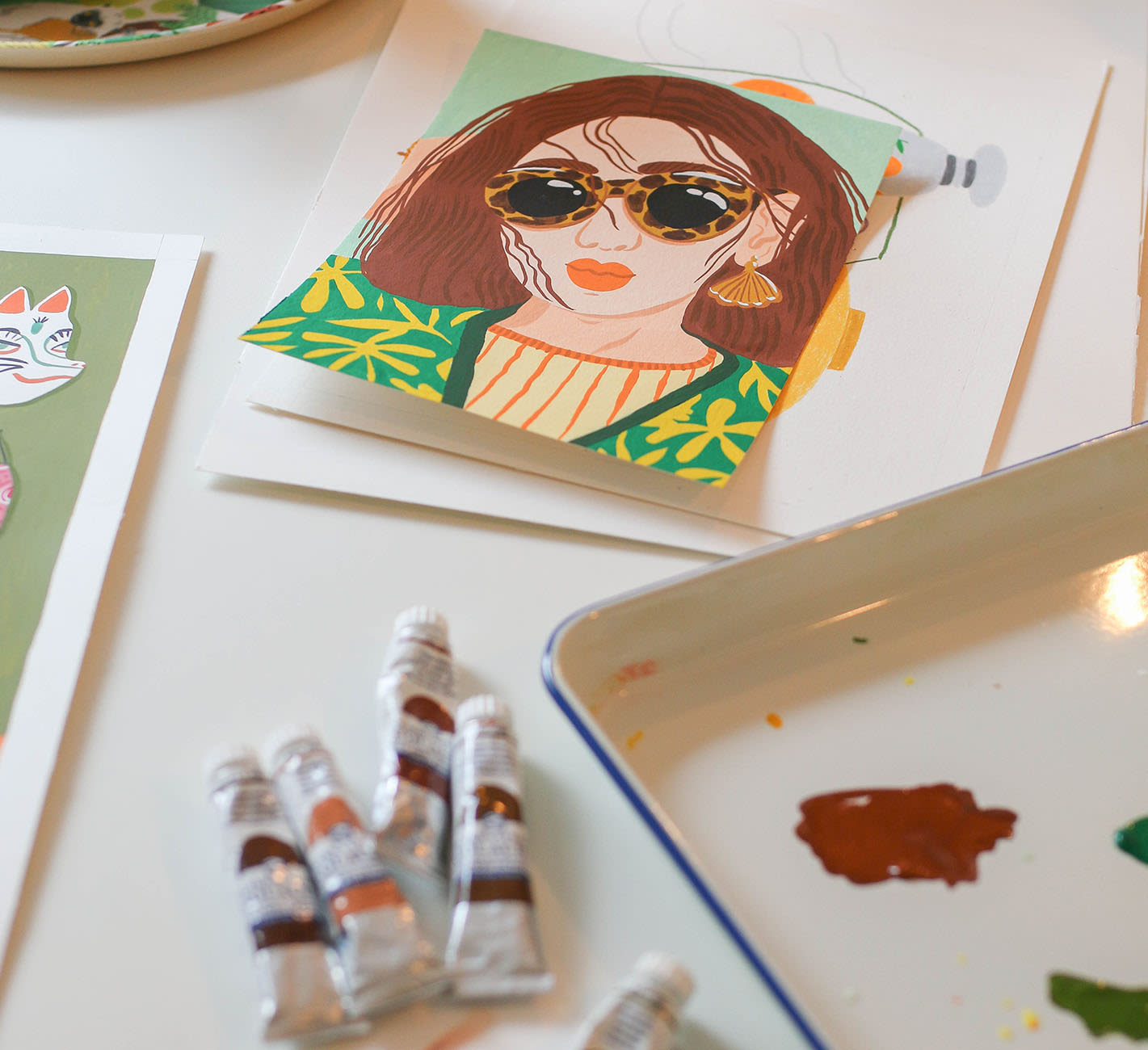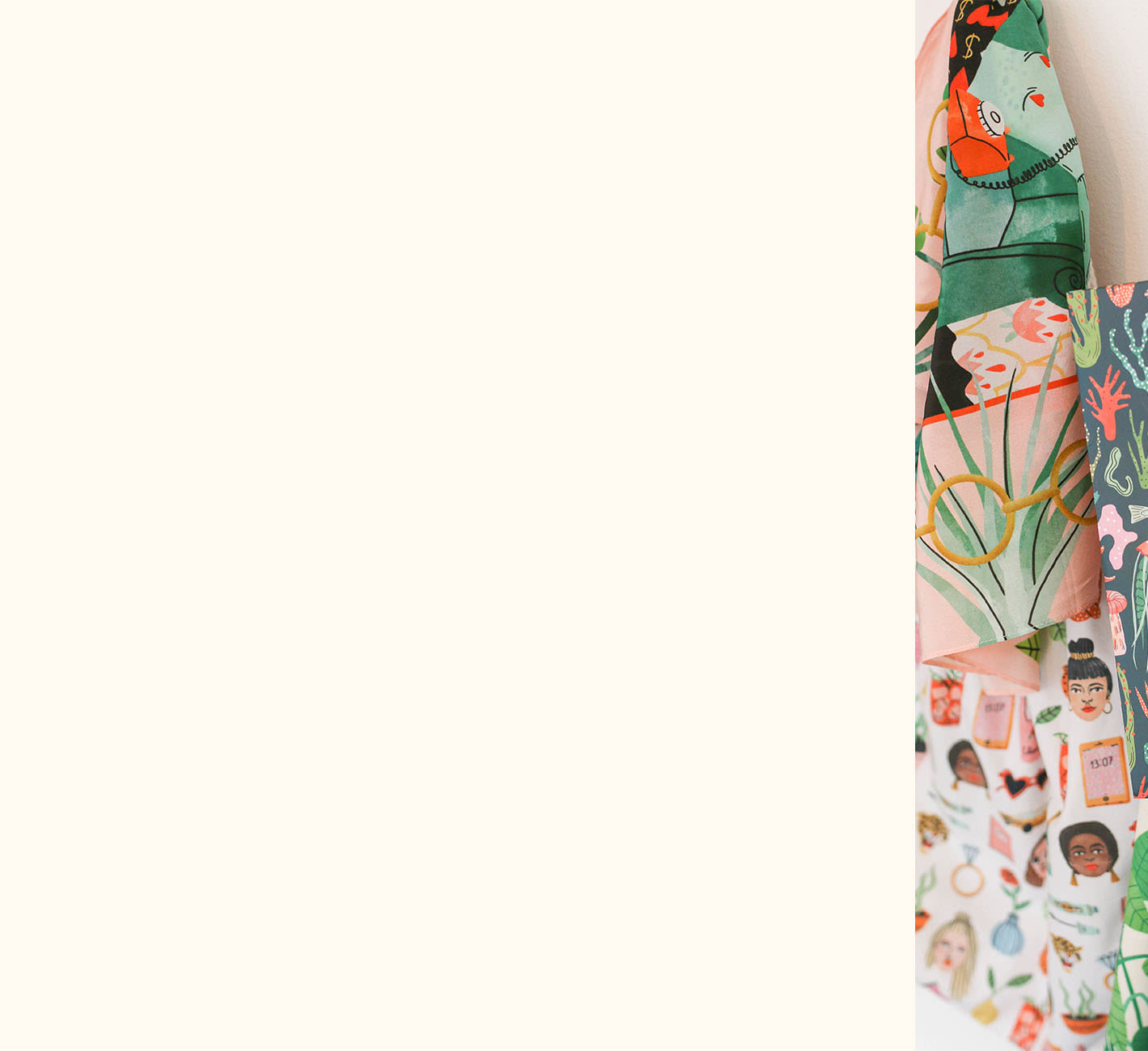If you’re an Anthropologie admirer, you’ll know that we have a soft spot for the bold and unique, whether that’s an intricately embroidered pattern on a dress or a window display that’s been handcrafted from paper leaves. That’s why the colourful designs of Bodil Jane were destined to cross our path.
Based in Amsterdam and raised by artist parents, her work explores a variety of themes from feminism to exotic wildlife, blending a dreamy and detailed world with a sprinkling of realism. She’s also the artist behind a mural in our brand-new Amsterdam store, which has just opened in the heart of Leidsestraat.
To celebrate the meeting of minds, join us as we take a look around her studio, crush on some of her latest pieces and chat all things creative.
How did you come to be an illustrator?
My mother is a ceramic artist and my father worked as a storyboard illustrator in advertising, so I suppose you could say it runs in my DNA. Growing up, there was never a time when we weren’t creating things. I fondly remember my father taking us to his atelier to do some charcoal drawings and the time my mother brought home old tiles so that we could make a mosaic mirror. It’s not like there was this one crystallised moment where I knew I wanted to be an artist, it was just a natural thing. The word ‘illustrator’ only came to me when visiting art schools in high school. I did a weekend pre-course at the Willem de Kooning Academy in Rotterdam and the rest is history.


Meet the Maker:
Bodil Jane
Words by Harriett Monaghan
What inspires your artwork?
I think that inspiration can be found anywhere. When you’ve been creating things from a very young age you just learn to see beauty all around. My parents had this very maximalist style. The home where I grew up had walls in an array of colours – peach, teal, mango, aubergine, olive green and they also collected objects from all over the world. I think this is why I love to visit flea markets, botanical gardens and busy environments. There’s so much to see whether that’s 19th century patterns in Dutch style houses or simply a beautiful sign or a funny dog in a backpack.
What is your favourite thing to draw?
There’s an endless joy in drawing nature – it’s very therapeutic. But I also love observing women. I photograph their hairdos and fashion in my mind and use it later for my illustrations.
You say women inspire you in particular — what is it about drawing feminist themes that really speaks to you?
The women I draw are fictional, but they’re a blend of who I see and who I want to be. I’m always inspired by people who are unapologetically themselves. I’m not interested in portraying model-like women. I don’t want my work to be an extension of the ones we see in the media. I’m far more interested in quirky and sweet rather than sexy and smooth. It’s important to me that women realise that they are amazing, in all their different forms. Being ‘perfect’ is boring!
Describe your artistic process.
My illustrations are like collages, featuring everything I’m inspired by at that moment. I start with watercolour, ink and gouache on paper, then I create illustrations in Photoshop using watercolour-like textures (it still feels very intuitive). It’s the ultimate mix of analogue and digital. I think you can kind of distinguish two different illustrators, the ones that are more focused on the concept and the idea behind the illustration and the ones that are more focused on aesthetics and material. I’m the last one! But I try to be more of the first one as well.
What’s the most rewarding aspect of your art?
There’s not an aspect of my art that isn’t rewarding. I love seeing my illustrations in action whether that’s a notebook that you can write in, a card that you can send to someone or a pyjama set that you can wear. I also love running into my own work by surprise – my book lying in the shop of Stedelijk Museum or friends sending pictures from Tokyo of my cards in a store. Every day people send me messages saying that my art makes them happy – it’s just the nicest feeling.
I think that inspiration can be found anywhere. When you’ve been creating things from a very young age you just learn to see beauty all around. My parents had this very maximalist style. The home where I grew up had walls in an array of colours – peach, teal, mango, aubergine, olive green and they also collected objects from all over the world. I think this is why I love to visit flea markets, botanical gardens and busy environments. There’s so much to see whether that’s 19th century patterns in Dutch style houses or simply a beautiful sign or a funny dog in a backpack.
What is your favourite thing to draw?
There’s an endless joy in drawing nature – it’s very therapeutic. But I also love observing women. I photograph their hairdos and fashion in my mind and use it later for my illustrations.
You say women inspire you in particular — what is it about drawing feminist themes that really speaks to you?
The women I draw are fictional, but they’re a blend of who I see and who I want to be. I’m always inspired by people who are unapologetically themselves. I’m not interested in portraying model-like women. I don’t want my work to be an extension of the ones we see in the media. I’m far more interested in quirky and sweet rather than sexy and smooth. It’s important to me that women realise that they are amazing, in all their different forms. Being ‘perfect’ is boring!
Describe your artistic process.
My illustrations are like collages, featuring everything I’m inspired by at that moment. I start with watercolour, ink and gouache on paper, then I create illustrations in Photoshop using watercolour-like textures (it still feels very intuitive). It’s the ultimate mix of analogue and digital. I think you can kind of distinguish two different illustrators, the ones that are more focused on the concept and the idea behind the illustration and the ones that are more focused on aesthetics and material. I’m the last one! But I try to be more of the first one as well.
What’s the most rewarding aspect of your art?
There’s not an aspect of my art that isn’t rewarding. I love seeing my illustrations in action whether that’s a notebook that you can write in, a card that you can send to someone or a pyjama set that you can wear. I also love running into my own work by surprise – my book lying in the shop of Stedelijk Museum or friends sending pictures from Tokyo of my cards in a store. Every day people send me messages saying that my art makes them happy – it’s just the nicest feeling.
Is there one print you created that you’re especially proud of?
That changes constantly. My most recent drawing tends to be what I’m most happy about. I’ve just finished a huge mural in the new Amsterdam Anthropologie store featuring tigers and a few more of my favourite animals – I love it. You spend so much time working on this one piece and part of the excitement is revisiting it.
Who would you invite to your dream dinner party?
You know, as much as I would like to name designers or famous figureheads from history, I would love to spend an evening with friends and family, eating really great food. That would make me so happy!
And finally, what is it that makes Amsterdam such a special place to call home?
The most amazing thing about Amsterdam is the quality of life here. The city is small, cosy, safe. You don’t need a car to live your life here. Everything can be reached within 30 minutes of biking. But that’s not to say it isn’t creative. Despite its size, it has an amazing fusion of culture and diversity and it’s very open and progressive. I was born in Amsterdam but later moved to Haarlem, a city in the Northwest. As a teenager I went by myself on adventures to the ‘big’ city and it’s always felt like home to me.
That changes constantly. My most recent drawing tends to be what I’m most happy about. I’ve just finished a huge mural in the new Amsterdam Anthropologie store featuring tigers and a few more of my favourite animals – I love it. You spend so much time working on this one piece and part of the excitement is revisiting it.
Who would you invite to your dream dinner party?
You know, as much as I would like to name designers or famous figureheads from history, I would love to spend an evening with friends and family, eating really great food. That would make me so happy!
And finally, what is it that makes Amsterdam such a special place to call home?
The most amazing thing about Amsterdam is the quality of life here. The city is small, cosy, safe. You don’t need a car to live your life here. Everything can be reached within 30 minutes of biking. But that’s not to say it isn’t creative. Despite its size, it has an amazing fusion of culture and diversity and it’s very open and progressive. I was born in Amsterdam but later moved to Haarlem, a city in the Northwest. As a teenager I went by myself on adventures to the ‘big’ city and it’s always felt like home to me.
Plan your visit to our brand-new store and discover Bodil’s hand-painted mural up close and personal.
Anthropologie Leidsestraat 32, AMSTERDAM FN-NL 1017PB
Anthropologie Leidsestraat 32, AMSTERDAM FN-NL 1017PB